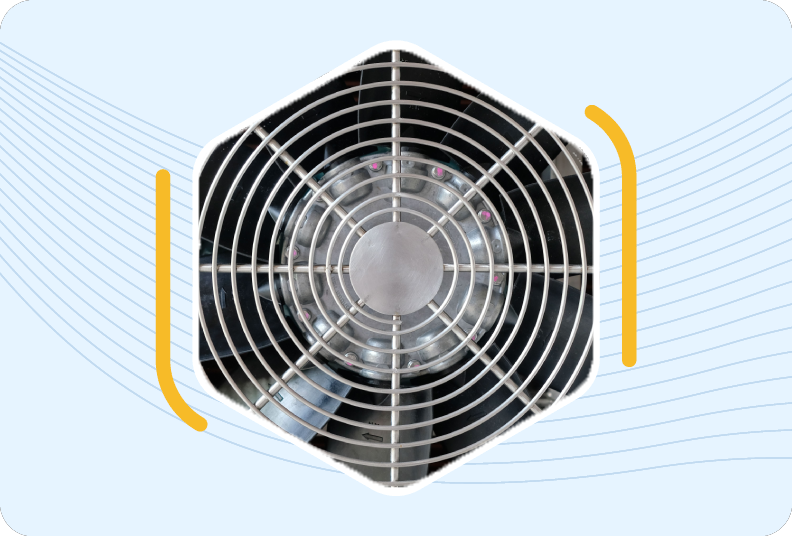Ceiling fan vs whole house fan is one of the most common comparisons homeowners make when searching for energy-efficient cooling solutions. Both systems provide comfort, improve airflow, and can dramatically reduce reliance on traditional air conditioning. By understanding the differences between these two options, you can create a cooling strategy that saves energy, lowers utility bills, and makes your home more sustainable. In this article, we’ll explore how each system works, their key benefits, and practical tips for choosing the right fan setup for your home’s unique needs.
Understanding ceiling fan vs whole house fan for energy-efficient cooling
When it comes to keeping your home comfortable, both ceiling fans and whole house fans play valuable roles. A ceiling fan circulates air within a single room, creating a gentle breeze that makes the space feel cooler. A whole house fan, on the other hand, ventilates your entire home by pulling in fresh outdoor air through open windows and exhausting hot air through attic vents. Understanding how each system contributes to cooling efficiency helps homeowners make informed decisions about installation, usage, and energy savings throughout the year.
Table of Contents
- How ceiling fans work
- How whole house fans work
- Energy efficiency comparison
- Comfort and climate fit
- Installation costs and considerations
- Noise and airflow performance
- Maintenance and longevity
- Best use cases and room tips
- Combining both for maximum savings
- Choosing the right cooling solution
How ceiling fans work
A ceiling fan doesn’t actually lower the room temperature, but it makes you feel cooler by creating a “wind chill” effect. The fan blades move air downward, increasing the rate at which heat and moisture evaporate from your skin. This simple principle allows you to raise your thermostat by a few degrees without sacrificing comfort—cutting your cooling costs significantly.
Most ceiling fans have reversible motors, allowing you to change blade direction. In summer, fans should rotate counterclockwise to push air down, creating a cooling breeze. In winter, reversing the blades helps redistribute warm air that rises to the ceiling, improving heating efficiency. This versatility makes ceiling fans an affordable, year-round comfort upgrade.
Modern ceiling fans are also designed with energy efficiency in mind. Models with ENERGY STAR® certification use up to 60% less energy than standard units and often include LED light kits, remote controls, and smart-home compatibility. Combined with proper sizing and placement—about 8–9 feet above the floor—they can make any living space more comfortable with minimal power use.
How whole house fans work
While a ceiling fan cools people, a whole house fan cools your entire home. Installed in the ceiling (usually in a central hallway), it pulls cooler outdoor air through open windows and vents hot indoor air out through attic vents. The process creates a powerful cross-ventilation effect that can drop indoor temperatures by 10 to 20°F in just minutes.
Whole house fans are best used when the outside air is cooler than the inside—typically early morning or evening. Running the fan during these hours removes accumulated heat from walls, floors, and furniture, preparing your home to stay cooler throughout the day. It’s a natural, energy-saving alternative to running your air conditioner for long periods.
Key components include:
- Fan blades and motor: Move large volumes of air quickly through the home.
- Ceiling grille: Allows air to pass from the living space into the attic.
- Attic vents: Provide an exit for hot air, preventing pressure buildup.
Because whole house fans move significant air volume, professional installation ensures the fan is sized correctly and that attic ventilation is adequate. With proper setup, homeowners can enjoy lower energy bills and fresher indoor air throughout warmer months.
Energy efficiency comparison
When comparing ceiling fan vs whole house fan efficiency, both options outperform air conditioning—but in different ways. Ceiling fans use as little as 20–75 watts per hour, making them one of the lowest-cost cooling devices available. Whole house fans use slightly more energy (200–700 watts per hour) but can replace A/C entirely on mild days, offering even greater overall savings.
According to the DOE’s whole-house ventilation guide, improving airflow through proper fan use can reduce cooling costs, enhance indoor air quality, and lessen the need for mechanical cooling. Running a ceiling fan allows you to raise your thermostat setting by a few degrees without losing comfort, while a whole house fan can cut air conditioning expenses by up to 75% during cooler months.
The key is to understand when to use each system. Ceiling fans are most effective while people are in the room, while whole house fans are ideal for ventilating during cooler times of day. With smart scheduling, you can rely less on mechanical cooling and more on natural airflow.

Comfort and climate fit
Choosing between a ceiling fan and a whole house fan often depends on your home’s layout and regional climate. In humid or coastal environments, ceiling fans tend to perform better since they enhance air movement without pulling in damp outdoor air. In contrast, dry climates—especially areas that cool off significantly at night—are ideal for whole house fans.
For example, homeowners in inland regions like Southern California, Arizona, or New Mexico can benefit tremendously from whole house fans. These areas experience large temperature swings between day and night, allowing the fan to draw in naturally cool air after sunset. Meanwhile, ceiling fans are the go-to solution for consistent comfort in bedrooms, living areas, and covered patios, regardless of weather conditions.
Ultimately, matching your fan choice to your local climate ensures optimal comfort and cost savings. A blended approach—using both systems—offers the flexibility to adapt to changing temperatures and humidity levels throughout the year.
Installation costs and considerations
Ceiling fan installation is typically straightforward, often costing between $150 and $400 including labor. It’s a fast project that can instantly improve airflow in any room. For homes without existing ceiling fan wiring, additional electrical work may slightly raise the price.
Whole house fans, on the other hand, require more extensive setup. Professional installation costs usually range from $1,000 to $3,000, depending on fan size, attic access, and electrical requirements. Proper sizing is crucial—a fan that’s too small won’t cool effectively, while one that’s too large could cause negative pressure if the attic isn’t vented properly.
Before installation, a qualified technician will assess your attic ventilation, insulation, and circuit capacity. Ensuring all components meet local building and electrical codes helps the system perform safely and efficiently. The right installation can make the difference between an average fan and an exceptional, long-lasting energy solution.
In both cases, investing in quality materials and professional installation pays off through improved comfort, safety, and long-term energy savings.
Noise and airflow performance
Noise level is a key factor when choosing between a ceiling fan vs whole house fan. Ceiling fans generally operate quietly, producing a soft hum that blends into background noise. Modern designs include precision-balanced blades and brushless motors to further reduce vibration and sound. In contrast, whole house fans move a large volume of air, which naturally creates more sound—especially when operating at high speeds. However, new insulated and belt-driven models have significantly improved noise performance, making them suitable even for bedrooms or hallways when installed correctly.
Airflow performance is another major consideration. A ceiling fan’s airflow is measured in cubic feet per minute (CFM), typically between 3,000 and 7,000 CFM depending on blade size and speed. Whole house fans move far more air—often exceeding 10,000 to 30,000 CFM—enough to exchange the air inside an entire home several times per hour. The right choice depends on whether you’re looking for targeted comfort or whole-home cooling.
For quiet operation, look for fans with multiple speed settings and insulated housings. Proper installation—including sealing gaps and ensuring attic venting—is the best way to reduce noise while maintaining high airflow efficiency.
Maintenance and longevity
Both systems require minimal upkeep but benefit from occasional maintenance to ensure longevity. Ceiling fans should be dusted regularly to prevent buildup on blades and motor housing, which can cause imbalance or humming sounds. Checking mounting brackets and blade alignment every few months helps maintain smooth operation. With basic care, most quality ceiling fans last 10 to 15 years.
Whole house fans require a bit more attention due to their higher airflow and attic placement. Homeowners should inspect fan blades, shutters, and vents annually for dust, debris, or obstructions. Lubricating moving parts (if applicable) and tightening motor mounts can extend the system’s lifespan to 15 to 20 years or more. Some models include self-sealing dampers that prevent heat loss when the fan isn’t in use, improving efficiency and reducing wear over time.
Regular maintenance not only extends lifespan but also preserves airflow performance and energy savings. A quick seasonal inspection ensures both fans remain ready for peak comfort and reliability year after year.
Best use cases and room tips
The ideal choice between a ceiling fan and a whole house fan often comes down to where and how you plan to use them. Ceiling fans shine in specific areas like bedrooms, living rooms, and patios where direct air circulation keeps occupants cool. They’re also great complements to air conditioning systems—allowing you to raise the thermostat and still feel comfortable while saving energy.
Whole house fans excel when used strategically. Opening a few windows in the evening or early morning allows the fan to pull in cool outdoor air and flush out trapped heat from the entire home. This is especially effective in two-story houses, where upper floors tend to retain more heat. In mild climates, a whole house fan can eliminate the need for air conditioning altogether for most of the year.
Quick tip: Use ceiling fans during the day for localized comfort, and run a whole house fan at night for fresh, cool air circulation. This combination offers 24-hour energy-efficient cooling that adapts to your daily routine.
Combining both for maximum savings
Instead of choosing one or the other, many homeowners discover that the smartest approach is combining both systems. A ceiling fan vs whole house fan comparison shows each has distinct advantages—so using them together creates a complete home cooling strategy.
Start by running the whole house fan during cooler hours to expel hot air and draw in fresh air. Once temperatures stabilize, ceiling fans maintain airflow and comfort throughout the day. This reduces or even eliminates the need for air conditioning, cutting energy consumption by up to 70%. The two systems complement each other perfectly, especially in regions with large temperature differences between day and night.
Pairing both systems with smart controls or timers can further enhance savings. Automated fans can detect temperature changes and switch on or off at optimal times, ensuring your home stays comfortable with minimal effort. The result is a quieter, cleaner, and more efficient living space.
Choosing the right cooling solution
Finding the right balance between a ceiling fan and a whole house fan depends on your home’s design, local climate, and comfort preferences. Ceiling fans provide consistent comfort and style for everyday living, while whole house fans deliver powerful ventilation and long-term energy savings. A combination of both gives you flexibility and efficiency across all seasons.
Before installing either system, consider factors like insulation, window placement, and attic ventilation. Consulting a licensed electrician or energy professional ensures your system is sized properly and installed safely. Once installed, the payoff is immediate—lower bills, cleaner air, and a more comfortable home.
In the end, both ceiling fans and whole house fans offer eco-friendly alternatives to heavy air conditioning use. Choosing wisely allows you to enjoy energy-efficient cooling and contribute to a more sustainable lifestyle—all while staying comfortable year-round.
John B is the head electrician at Specialty Electric, where he brings over 15 years of dedicated experience to every project he handles. Known for his technical expertise and meticulous attention to detail, John specializes in high-end electrical installations and advanced troubleshooting. His commitment to safety, efficiency, and the latest industry standards makes him a trusted name among clients seeking reliable and innovative electrical solutions.



